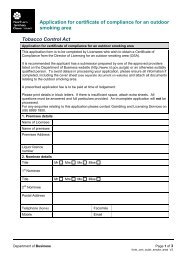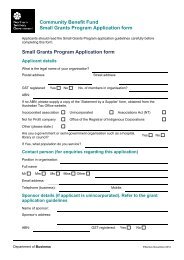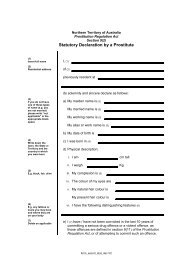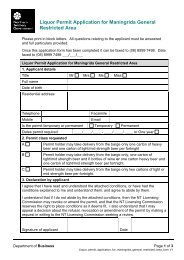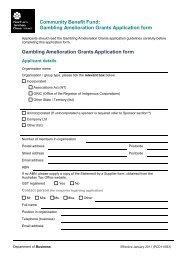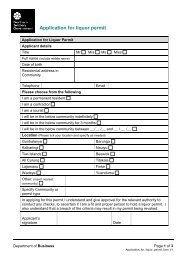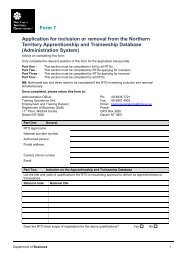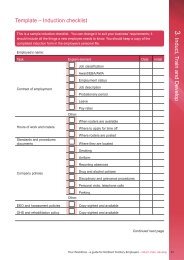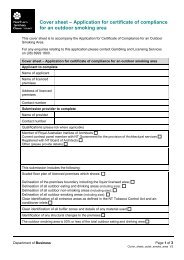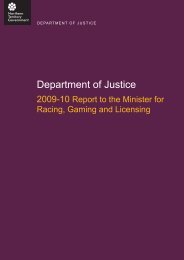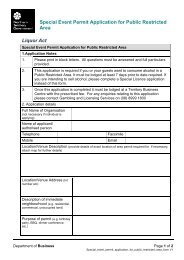corporate Governance - Department of Business - Northern Territory ...
corporate Governance - Department of Business - Northern Territory ...
corporate Governance - Department of Business - Northern Territory ...
- No tags were found...
You also want an ePaper? Increase the reach of your titles
YUMPU automatically turns print PDFs into web optimized ePapers that Google loves.
<strong>corporate</strong> governanceThe department’s <strong>corporate</strong> governance isguided by the following principles:• strong leadership with a clearly definedexecutive and a robust and active governancecommittee structure• accountability through the implementation<strong>of</strong> appropriate internal controls and<strong>corporate</strong> policies• effective stewardship <strong>of</strong> resources throughcompliance with legislation, <strong>Northern</strong> <strong>Territory</strong>Government policies and internal procedures• comprehensive planning and a continuousimprovement approach to managementand service delivery• cohesive governance frameworks addressingthe department’s primary resources - people,finances and information• a focus on risk and appropriate risk mitigationthrough a risk management framework• ethical behaviour expectations communicatedat all levels with fair and equitable treatment,respect for others, and pr<strong>of</strong>essional andresponsive service delivery• clear advice and guidance for staff toensure that governance requirementsare well understood• communication with stakeholders,including ministers and government.<strong>Governance</strong> CommitteesThe committees report to the Chief Executivethrough the Management Board.Risk Management and Audit CommitteeThe Risk Management and Audit Committee:• oversees risk management activities, auditand review programs for the department• monitors progress against recommendationsarising from audits and reviews conductedunder these programs• oversees reviews that are required under theconditions <strong>of</strong> the ICT outsourcing contracts.In 2009–10 the department developed a<strong>Business</strong> Continuity Management Policy toprovide a framework for its business continuitymanagement. The framework should minimisethe complexity while maximising the flexibility<strong>of</strong> plans, with incident and situation specificplans developed for preparation, responseand recovery elements <strong>of</strong> business continuity(e.g. cyclone, flood, reduced workforce). Thedepartment continued to monitor and updaterisk pr<strong>of</strong>iles to mitigate risks to its operations.The Risk Management and Audit Committeeis chaired by the Executive Director SharedServices. Its members are the Chief Executive,Director Finance Services and Senior DirectorInformation and Communication TechnologyServices. A customer representative fromthe <strong>Department</strong> <strong>of</strong> Lands and Planning is anexternal member and a representative <strong>of</strong> theNT Auditor-General’s Office participates in anobserver role.With the department’s whole-<strong>of</strong>-governmentroles in providing shared services andmaintaining critical <strong>corporate</strong> systems, theNT Auditor-General’s Office continued itscomprehensive audit program during 2009–10.The audit findings were mostly satisfactory, withsome isolated instances <strong>of</strong> control breakdowns,non-observance <strong>of</strong> procedures and minor issuesnoted. A summary <strong>of</strong> the findings for this year’sexternal audits is at Appendix II.The department continues to undertake internalreviews across the agency to improve processesand provide assurance. The internal reviewscompleted in 2009–10 focused on ICT disasterrecovery capability and security policies andstandards. In addition to the internal reviews,a number <strong>of</strong> process reviews were undertaken.A summary <strong>of</strong> internal reviews in 2009–10 isat Appendix III.Human Resource <strong>Governance</strong> CommitteeThe Human Resource <strong>Governance</strong> Committee:• oversees and advises on human resourcingrequirements for the department and itsbusiness divisions• reviews and endorses recruitment action• actively monitors unattached <strong>of</strong>ficers• undertakes a human resources governancerole for the department.In 2009–10 the committee continued to activelyand cohesively manage human resources andemployment strategies across the department.<strong>Department</strong> <strong>of</strong> <strong>Business</strong> and Employment Annual Report 2009–1019
<strong>corporate</strong> governanceThe committee is chaired by the ExecutiveDirector Shared Services. Its members are theSenior Director Information and CommunicationTechnology Services, Executive Director<strong>Business</strong> and Industry Development andDirector People and Information (secretariat).The committee meets weekly and reportsregularly to the Management Board. Proceduresgoverning the functions and terms <strong>of</strong> referencehave been developed and disseminated acrossthe department and business divisions.All unattached <strong>of</strong>ficers from stage 1 <strong>of</strong> theCorporate Services Review co-locationproject have been successfully placed.In 2010–11 the committee will again beintegral to the placing <strong>of</strong> unattached <strong>of</strong>ficersas a result <strong>of</strong> Corporate Services Reviewstage 2 projects, the implementation <strong>of</strong>electronic invoice management.The committee also oversees OH&Srequirements including site committee structures,roles and OH&S management plans.Occupational Health and SafetySteering CommitteeThe department’s Occupational Health andSafety Steering Committee:• ensures that mechanisms are in place toidentify and address OH&S issues• ensures that site-specific OH&S committeesmeet regularly• ensures the department’s OH&S guidelinesare available and understood by staff.The committee is chaired by the Director Peopleand Information and comprises representativesfrom each worksite, together with a regionalrepresentative.The committee monitors the department’sOH&S performance, reports to the ManagementBoard quarterly and, where required, developsOH&S policy for endorsement by the board andthe Chief Executive.The committee is actively working towardsachieving compliance with the requirements <strong>of</strong>the Workplace Health and Safety Act and thiswill be completed in 2010–11.Information Management CommitteeThe Information Management Committee:• directs the development <strong>of</strong> the department’sinformation management strategy byoverseeing the ICT <strong>Governance</strong> Frameworkand facilitating the strategic planning <strong>of</strong>ICT requirements• develops and reviews the department’s ICTpolicies and standards for the assessment<strong>of</strong> technology proposals to ensure they meetdepartmental ICT objectives• monitors ICT projects and the implementation<strong>of</strong> appropriate new technologies to ensureconsistency with the department’s strategicdirection and its ICT <strong>Governance</strong> Framework.The committee is chaired by the ExecutiveDirector Corporate Services. Its members areDirector Data Centre Services, Director ProgramOffice, Director <strong>Business</strong> Support, DirectorICT Policy and Strategy, Director HumanResource Services and Director CorporateCommunications and Secretariat.The committee monitored and providedsupport a number <strong>of</strong> major ICT projects during2009–10 and continued to implement policiesand procedures following the implementation<strong>of</strong> the ICT <strong>Governance</strong> Framework in 2008–09.In 2010–11 the committee will focus on thedevelopment <strong>of</strong> policies and processes topromote energy efficient and environmentallysustainable ICT in the department.Management EnvironmentExecutive Management GroupThe Executive Management Group is a key part<strong>of</strong> the department’s leadership framework. TheChief Executive has the primary responsibility forproviding strategic leadership to the department.The group meets weekly and consists <strong>of</strong> theChief Executive, Executive Director SharedServices, Executive Director <strong>Business</strong> andIndustry Development, Executive DirectorEmployment and Policy Coordination, ExecutiveDirector <strong>Business</strong> Support and ExecutiveDirector Corporate Services.Management BoardThe board provides advice to the ChiefExecutive and the Executive ManagementGroup on governance across the departmentand focuses on managing the operation <strong>of</strong>the department and the achievement <strong>of</strong> thedepartment’s objectives and strategies.<strong>Department</strong> <strong>of</strong> <strong>Business</strong> and Employment Annual Report 2009–1020
<strong>corporate</strong> governanceThe board reviews, endorses and approves<strong>corporate</strong> policies to provide a cohesiveapproach to the delivery <strong>of</strong> organisationalstrategies and to monitor and reviewdepartmental performance.Chaired by the Chief Executive, the ManagementBoard is the department’s principal planning anddecision making body and meets monthly to:• provide advice and assist the Chief Executivein governing the department and meetingstatutory responsibilities• facilitate a cooperative approach to thedelivery <strong>of</strong> organisational strategiesand to monitor and review departmentalperformance.Members <strong>of</strong> the Management Board are shownin the Executive Structure on page 6.Ethical StandardsThe department’s values are underpinned bythe <strong>Northern</strong> <strong>Territory</strong> Public Sector (NTPS)Principles and Code <strong>of</strong> Conduct, whichprovide guidance to staff on a range <strong>of</strong> moraland ethical issues they may face during theiremployment. The Code <strong>of</strong> Conduct forms part<strong>of</strong> the terms and conditions <strong>of</strong> employment andis therefore binding on all employees. All newemployees to the department are given a copy<strong>of</strong> the Code <strong>of</strong> Conduct booklet.The binding nature <strong>of</strong> the Code <strong>of</strong> Conductis explained to all new staff at inductionprograms. As the department is responsiblefor the collection and retention <strong>of</strong> sensitivepersonal information for all <strong>Northern</strong> <strong>Territory</strong>Government employees, privacy requirementsfor information are highlighted.The department recognises that any conflict<strong>of</strong> interest, whether real or perceived, erodesconfidence in the integrity <strong>of</strong> the departmentspecifically, or <strong>of</strong> the <strong>Northern</strong> <strong>Territory</strong>Government in general. All Management Board,Executive Directors and pertinent senior staffcompleted a full disclosure declaration onan annual basis to declare private and otherinterests that might result in a conflict <strong>of</strong> interest.If such interests are identified, appropriate actionis taken to resolve the conflict or prevent it fromarising. Completed declarations are held asevidence <strong>of</strong> disclosure and, as such, providesome protection against unfounded allegations <strong>of</strong>bias concerning department advice or decisions.Specific departmental policies have beendeveloped to guide employees in ethical issuessuch as outside employment, harassment inthe workplace, addressing grievances, gifts andbenefits, and preventing and responding to fraudand dishonesty. The policies and procedures arelocated on the staff-only intranet site, where theyare available to all employees.PlanningCorporate PlanThe Corporate Plan 2009–11 stresses theimportance <strong>of</strong> its employees to provide acapable and committed workforce which thenunderpins the success <strong>of</strong> the departmentmeeting its strategic priorities.The plan is due for review in 2010–11. Thiswill include setting the strategic priorities andfocusing on supporting the department to alignits work over the coming two to three years to<strong>Territory</strong> 2030.<strong>Business</strong> Plans<strong>Business</strong> plans for individual services,providing practical tasks and projects to becompleted in the coming year, contributeto the overall departmental objectives andsupport the Corporate Plan. These businessplans are developed in consultation with staffand stakeholders. Progress against priorityprojects is reported monthly to the ManagementBoard. This provides a regular update on keyorganisational goals and ensures a coordinatedapproach to performance monitoring.Performance MeasuresMonthly reporting to Management Board hasbeen refined to highlight strategic priorities forgovernment and the department. Significantwork will be done on performance measures in2010–11 to give the board a useful overview.The measures are compiled from a range <strong>of</strong>data sources. Key Performance Indicators(KPIs) for 2009–10 align with the CorporatePlan and focus on qualitative and timelinessmeasures rather than on more traditionalquantitative measures.Reporting against the KPIs for 2009–10 beginson page 45.<strong>Department</strong> <strong>of</strong> <strong>Business</strong> and Employment Annual Report 2009–1021
<strong>corporate</strong> governanceCommunicationThe department uses several mechanismsfor ensuring effective internal and externalcommunication for regional, local, nationaland international audiences and stakeholders.External CommunicationsThe department connects with business,industry and skilled workers throughexpos, shows, conferences, awards andcorrespondence. Staff communicate withbusiness on a daily basis via site visits,telephone and email.Regional newspapers columns are managedby the department to keep regional Territoriansadvised <strong>of</strong> the activities, services and programs.The department’s websites provide access tobusiness services, activities, strategic direction,policy and projects. The information andservices is primarily target at business, industry,skilled workers, business and skilled migrantsand the community. There are seven websites:• the department site• Growing the <strong>Territory</strong>• The <strong>Territory</strong>• Buy <strong>Territory</strong>• October <strong>Business</strong> Month• InvestNT• <strong>Business</strong> and Skilled Migration.In the event <strong>of</strong> an emergency, the emergencymanagement group is contacted by anyavailable means for immediate action.The department also maintains the sharedservices intranet as the main communicationtool with all other government departments.This provides departments with information onwhole-<strong>of</strong>-government services, procedures andforms in the delivery <strong>of</strong> <strong>corporate</strong> services.Internal CommunicationsThe department reviewed internal communicationin early 2010 with initiatives due for release laterin 2010.The staff intranet site is a hub for news,information, policies, procedures and formsfor department staff. This includes newsclippings, radio alerts and online news articlesreferencing issues and activities relevant to thedepartment are posted to the staff intranet daily.The redevelopment <strong>of</strong> the staff site is nearingcompletion and will enhance staff engagementand communication processes.AccountabilitiesStatutory AccountabilityThe department is required to comply with theFinancial Management Act, Superannuation Act,Public Sector Employment and Management Actand other employment-related legislation suchas the Anti-Discrimination Act and the WorkplaceHealth and Safety Act. Through the department’sOrientation Program, staff are made aware <strong>of</strong>the department’s <strong>corporate</strong> governanceframework and the relevant statutes, and trainingin these matters is included in the department’straining plans.Legislation AdministeredThe department is responsible for administeringthe following Acts:• Biological Resources• Desert Knowledge Australia• Information (Part 9 except ArchivesManagement)• <strong>Northern</strong> <strong>Territory</strong> Products Symbol• Procurement• Year 2000 Information Disclosure.The Biological Resources Act and subordinatelegislation provide for and regulatebio-prospecting in the <strong>Northern</strong> <strong>Territory</strong>.The Desert Knowledge Australia Act andsubordinate legislation encourage andfacilitate learning, research and sustainableeconomic and social development relatingto deserts and arid lands and establishDesert Knowledge Australia.The Information Act (Part 9 except ArchivesManagement) relates to <strong>Northern</strong> <strong>Territory</strong>Government records management.The <strong>Northern</strong> <strong>Territory</strong> Products Symbol Actand subordinate legislation authorise the use <strong>of</strong>a products symbol to distinguish and promotethe sale <strong>of</strong> products made in the <strong>Territory</strong>.The Procurement Act and subordinatelegislation provide a cohesive framework forthe procurement <strong>of</strong> supplies by governmentagencies and aim at achieving value formoney from expenditure on supplies by way <strong>of</strong><strong>Department</strong> <strong>of</strong> <strong>Business</strong> and Employment Annual Report 2009–1022
<strong>corporate</strong> governanceData Centre ServicesDCS undertakes risk management inaccordance with the department’s RiskManagement Framework. Prior to the release<strong>of</strong> Treasurer’s Direction R2.1 – InsuranceArrangements in November 2008, DCSself-insured all insurable risks through thedepartment.As a result <strong>of</strong> undertaking risk assessments<strong>of</strong> its insurable risks, DCS has policies<strong>of</strong> commercial insurance for workerscompensation, property damage, productliability, public liability and motor vehicles. Thetotal cost <strong>of</strong> premiums for commercial policies <strong>of</strong>insurance increased to $53 726 in 2009–10 from$27 300 in 2008–09, with 2009–10 reflectingthe first full financial year’s costs <strong>of</strong> commercialinsurance since the release <strong>of</strong> Treasurer’sDirection R2.1. There were no claims oncommercial insurance policies during 2009–10or 2008–09; however, there were claims on selfinsuredrisks prior to the release <strong>of</strong> Treasurer’sDirection R2.1. Details <strong>of</strong> self-insurance claimsfor 2009–10 are in Appendix IV.Government Printing OfficeThe GPO undertakes risk managementin accordance with the department’s RiskManagement Framework. Prior to the release <strong>of</strong>Treasurer’s Direction R2.1 the insurable risks <strong>of</strong>the GPO were self insured throughthe department.The GPOengaged a consultant to review itsinsurable risks in 2008–09 and undertookinternal risk assessments in the process <strong>of</strong>obtaining commercial insurance policies forworkers compensation, property damage,product liability, public liability and motor vehiclesfor 2009–10. The total cost <strong>of</strong> premiums forcommercial insurance policies in 2009–10 and2008–09 was $50 915 and $14 553 respectively.The increase in costs <strong>of</strong> commercial insurancewas due to 2009–10 being the first full financialyear since the release <strong>of</strong> Treasurer’s DirectionR2.1. There were no claims on commercialinsurance policies during 2009–10 or 2008–09.Details <strong>of</strong> self-insurance claims for 2009–10and 2008–09 are in Appendix IV.NT FleetNT Fleet undertakes risk management inaccordance with the department’s RiskManagement Framework. NT Fleet undertakesinternal risk assessments <strong>of</strong> its insurablerisks, which resulted in policies <strong>of</strong> commercialinsurance being obtained for workerscompensation and damage to the motorvehicle fleet due to natural disasters. Thetotal cost <strong>of</strong> premiums for commercial insurancepolicies in 2009–10 and 2008–09 was $148 660and $44 297 respectively. The significant increasein the cost <strong>of</strong> premiums in 2009–10 reflects thecosts <strong>of</strong> insurance for the first full financial yearsince the release <strong>of</strong> Treasurer’s Direction R2.1and the procurement <strong>of</strong> commercial insurancefor damage to the motor vehicle fleet fromnatural disasters.Prior to the release <strong>of</strong> Treasurer’s DirectionR2.1, the insurable risks <strong>of</strong> NT Fleet wereself-insured through the department. Details<strong>of</strong> the cost <strong>of</strong> claims <strong>of</strong> self-insured risks for2009–10 and 2008–09 are in Appendix IV.GREENER GOVERNMENTAs the Shared Services provider thedepartment is charged with leading anddeveloping initiatives and activities designedto reduce carbon footprint and improveenvironmental practices for government leasedbuildings, the government fleet, ICT services,business, procurement and printing.<strong>Department</strong>al Green Office InitiativesThe department has continued to makeconcerted efforts to reduce its carbon emissionsand energy usage in 2009–10 through a range<strong>of</strong> activities.The following initiatives are encouraged acrossall departmental buildings and locations:• defaulting department computers todouble-sided and black and white printing• paper recycling bins installed acrossbusiness units• toner and ink cartridge recycling binsin place throughout the department• using intranet and internet to publishlarge documents• changing behaviours to switch <strong>of</strong>flights and computers when not in use• review and rationalise the department’sfleet where possible• active participation in Earth Hour<strong>Department</strong> <strong>of</strong> <strong>Business</strong> and Employment Annual Report 2009–1024
<strong>corporate</strong> governance• encouraging all staff to switch <strong>of</strong>f all electricalequipment when not in use• building lights and air-conditioning pre-timedto switch <strong>of</strong>f after <strong>of</strong>fice hours and operate ona 2-hour timer for outside hours use• timers installed on photocopiers and hotwater heaters to reduce after hours use<strong>of</strong> electricity• introduction <strong>of</strong> zone lighting controlsin certain buildings.Chan Data CentreData centres around the world are facingan increasing demand to provide additionalcomputing capacity. Growing demand byagencies for IT infrastructure and managedcomputing services has resulted in a largeincrease in the number <strong>of</strong> servers and datastorage devices in the Chan Data Centre.Electricity usage is therefore increasing.Within this constraint, staff continue to monitorelectricity usage to ensure effective use <strong>of</strong>energy and minimal wastage.The department has implemented a ‘virtualisefirst’ policy, where business systems are hostedin a virtualised server environment rather thanphysical server devices. This has been a keyfactor in enabling the department to reduce itstotal potential carbon emissions by 50 metrictonnes per month.NT FleetNT Fleet has implemented the government’sGreening the Fleet strategy, which will seea 20% reduction in the average CO 2gasesproduced by its passenger and light commercialfleets measured in gm/km over the next 5 years.Individual agency targets were established for2009–10 and 4-cylinder vehicles now comprise64%<strong>of</strong> the fleet. However, the focus in 2009–10shifted from 4-cylinder vehicles to the acquisition<strong>of</strong> more fuel efficient vehicles, particularly thosevehicles with a ‘green vehicle guide’ rating <strong>of</strong>5.5 or higher.Government Printing OfficeThe GPO is investigating options to jointhe National Printing Industry SustainableGreen Print Environmental ManagementCertification System.NT Property ManagementThe <strong>Northern</strong> <strong>Territory</strong> Government approvedthe Green Office Building Policy in December2009 as part <strong>of</strong> its Climate Change Policy.The Green Office Building Policy appliesto leases <strong>of</strong> 2000 square metres or more.Owners <strong>of</strong> existing buildings are encouragedto achieve a 4.5 Star NABERS Base BuildingEnergy Rating. This standard applies toexisting buildings from 1 July 2012 and isbeing addressed in lease renewal negotiationsas leases expire. From 1 January 2010, newdevelopments are required to achieve 5 StarNABERS and 5 Star Green Star Ratings.The Green Office Building Policy requiresgovernment to set environmental standards fortenancies in leased buildings. These standardsare being developed through the WorkplaceDesign and Management Policy, which is dueto be submitted to government for review andapproval in 2010.NT Property Management works closely with the<strong>Department</strong> <strong>of</strong> Construction and Infrastructureto achieve energy efficiencies in governmentleasedaccommodation. Energy usage reportshave been prepared for all significant leases,with recommendations implemented duringlease negotiations. In 2008–09, a draft GreenLeasing strategy to support the government’sproposed climate change policy was developed.The proposed policy settings are consistentwith other state and territory jurisdictions. Therecommended Rating Tools for buildings are:• National Australian Built Environment RatingSystem (NABERS) – Energy Efficiency;Green Star – Environmental Sustainability• existing buildings - 4.5 Stars NABERS forleased space over 2000 square metres and3 year term• new buildings - 5 Stars NABERS andGreen Star.<strong>Department</strong> <strong>of</strong> <strong>Business</strong> and Employment Annual Report 2009–1025
<strong>corporate</strong> governanceecoBiz NTEcoBiz NT is an eco-efficiency program thatassists small and medium <strong>Northern</strong> <strong>Territory</strong>businesses to reduce their environmentalimpact and save money at the same time.The program has been operating since2008–09. In 2009–10 ecoBiz NT avoided theproduction <strong>of</strong> approximately 753 tonnes <strong>of</strong> CO 2and the use <strong>of</strong> 14 700 kilolitres <strong>of</strong> water, 920litres <strong>of</strong> LPG, four forest trees (paper savings)and 400 litres <strong>of</strong> solvent based degreaser.ICT ServicesThe department is working with ICT serviceproviders to reduce carbon emissionsassociated with services delivered underoutsourced contracts.New contracts require service providers tocomply with standards for waste reduction,disposal and energy use star ratings.With most ICT equipment having a relativelylimited life, the focus for the contracts is onmaking environmental gains through reuse,recycling and reducing waste in the disposal<strong>of</strong> ICT equipment.Domain ‘Green’ BuildingThe Domain is a building leased prior to theintroduction <strong>of</strong> the Green Office Building Policy.The Domain is designed to achieve a 5 StarNABERS Base Building Energy Rating andthe owner is required to maintain a minimumperformance level <strong>of</strong> 4.5 Stars.<strong>Department</strong> <strong>of</strong> <strong>Business</strong> and Employment Annual Report 2009–1026



